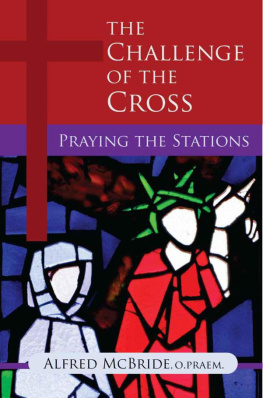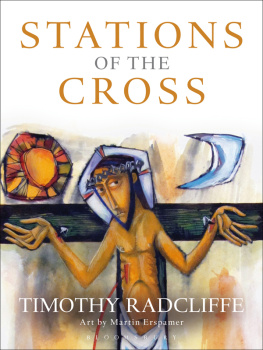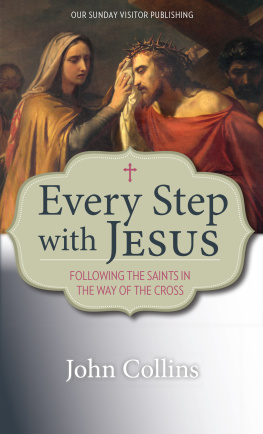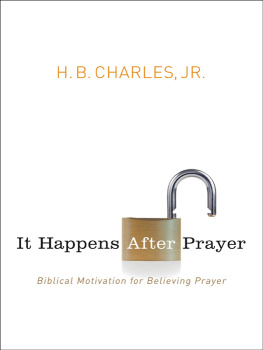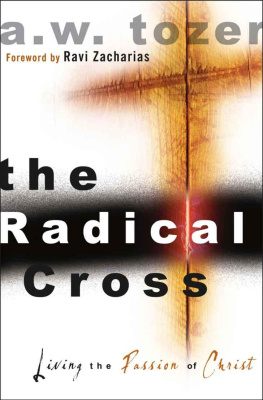In accord with the Code of Canon Law, I hereby grant my permission to publish The Challenge of the Cross: Praying the Stations, by Alfred McBride, O. Praem.
Most Reverend Joseph R. Binzer
The permission to publish is a declaration that a book or pamphlet is considered to be free from doctrinal or moral error. It is not implied that those who have granted the permission to publish agree with the contents, opinions or statements expressed.
Scripture passages have been taken from New Revised Standard Version Bible, copyright 1989 by the Division of Christian Education of the National Council of the Churches of Christ in the U.S.A., and used by permission.
All rights reserved.
McBride, Alfred.
The challenge of the cross : praying the stations / Alfred McBride.
p. cm.
Includes bibliographical references and index.
ISBN 978-1-61636-303-1 (alk. paper)
1. Stations of the Cross. 2. Catholic ChurchPrayers and devotions. I. Title.
Copyright 2011, by Alfred McBride, O. Praem. All rights reserved.
Published by St. Anthony Messenger Press
28 W. Liberty St.
introduction
As I move into my later years, I am attracted more than ever to the Stations of the Cross.
Perhaps its because Christ spent his last moments on earth publicly bearing all kinds of physical painbeatings, bleeding, weakness, and a series of humiliationsand because I have witnessed (and paid more attention to) suffering of all kinds in more recent years.
Perhaps its also because Jesus moves me to accept the various slings and arrows of life, not hiding them, rather publicly living my own version of the cross in union with my Lord. In so doing I feel much closer to Jesus in his Passion and am humbled by his courage and love. I am more aware of the salvation he won for me.
I know now more than ever that praying the Stations of the Cross can lead me to a treasure of graces and spiritual growth.
follow the passion of christ
The Stations of the Cross, or Way of the Cross, is a devotional practice that follows the Passion of Christ from his condemnation before Pilate to his death on the cross and his burial. Originally these stations were developed in Jerusalem and had great appeal for the pilgrims to the Holy Land as early as the fourth century. Pilgrims processed from one site in the Holy Land (a station) to the next site, and at each site expressed their faith in hymns, prayers, and silence as a way of remembering and being part of Christs own way of the cross.
In the Middle Ages the Franciscans spread throughout the church this devotion that an English pilgrim, William Wey, in 1428 first named Stations of the Cross. The Holy See had already attached an indulgence to this pilgrimage, and later the indulgence was given to those who could not travel to Jerusalem but did so in spirit back home.
Many monasteries and retreat centers created outdoor stations after the Jerusalem model. Eventually, most churches and chapels mounted fourteen images of these scenes on their walls, with images ranging from pictorial representations to abstract symbols. For private devotion, people walked from station to station. For public devotion a priest, accompanied by servers and someone leading with a crucifix, processed through the church from station to station while the congregation followed the prayers and hymns from their pews.
In recent times, a fifteenth station, Jesus Rises from the Dead, has often been added so that the full reality of Christs saving work in his death and resurrection is celebrated. On Good Friday 1991, Pope John Paul II celebrated an alternative to the traditional stations that reflects more deeply on the scriptural accounts of Christs Passion, as seen in the following comparison:
traditional stations
1. Jesus Is Condemned to Death
2. Jesus Takes His Cross
3. Jesus Falls the First Time
4. Jesus Meets His Mother
5. Simon of Cyrene Helps Jesus
6. Veronica Wipes Jesus Face
7. Jesus Falls Again
8. Jesus Speaks to the Daughters of Jerusalem
9. Jesus Falls the Third Time
10. Jesus Is Stripped of His Clothing
11. Jesus Is Nailed to the Cross
12. Jesus Dies on the Cross
13. Jesus Is Taken Down from the Cross
14. Jesus Is Laid in the Tomb
15. Jesus Rises from the Dead
pope john paul IIs stations
1. Jesus in the Garden of Gethsemane
2. Jesus, Betrayed by Judas, Is Arrested
3. Jesus Is Condemned by the Sanhedrin
4. Jesus Is Denied by Peter
5. Jesus Is Judged by Pilate
6. Jesus Is Scourged and Crowned with Thorns
7. Jesus Bears the Cross
8. Jesus Is Helped by Simon the Cyrenian to Carry the Cross
9. Jesus Meets the Women of Jerusalem
10. Jesus Is Crucified
11. Jesus Promises His Kingdom to the Good Thief
12. Jesus Speaks to His Mother and the Disciple
13. Jesus Dies on the Cross
14. Jesus Is Placed in the Tomb
For The Challenge of the Cross , we will follow the traditional stations and add the fifteenth station, Jesus Rises from the Dead.
how to pray the stations
The Stations of the Cross, one of the churchs oldest and most durable forms of popular piety or devotion, extends the liturgical life of the people but does not replace it. Devotions such as the rosary and slow, prayerful reading of Scripture are time-honored ways to rouse and enrich our faith and open us to a stronger commitment to the sacraments and the Liturgy of the Hours.
The Challenge of the Cross is ideal for lenten devotions at parish churches or by other groups wishing to pray together. I also recommend that The Challenge of the Cross become a regular addition to a personsprivate devotion at home, during long commutes, or in assisted living, nursing care, or hospice situations. While Lent is a common time to pray the Stations of the Cross, we can find much inspiration from the devotion throughout the year.
Each of the fifteen stations in The Challenge of the Cross includes a Reflection that focuses on Jesus thoughts and acts in his Passion and that helps you apply a station to your own life. Station themes include references to everyday life experiences, such as caregiving; making rash judgments; facing pain and death; dealing with disappointments, losses, and betrayals; finding discipline for the life journey; recognizing the need to forgive and be forgiven, and so on. Following each Reflection, you will find a Scripture to Ponder, a Prayer to Meet the Challenge of the Cross, and a Closing Prayer.
In a congregational setting, the leader can open the devotion by announcing each station and saying, We adore you, O Christ, and we praise you, to which the group then responds, For by your holy cross, you have redeemed the world. The leader and the group read aloud the two-part reflection, followed by the leader or another reader saying, Let us pray to meet the challenge of the cross. The group can together recite the Scripture to Ponder. The leader or another reader then begins the petition, with the group responding. Each station ends with all reciting the Closing Prayer.
To enhance the devotion, whether in a church or private setting, each station could open with a hymn from any available hymnal. Typically this could be the English version of the Stabat Mater, whose words can be found on page 9. The Stabat Mater is a thirteenth - century hymn to Mary that meditates on her suffering during the crucifixion of her son, Jesus. The song would be ideal to begin or end each Station of the Cross.

